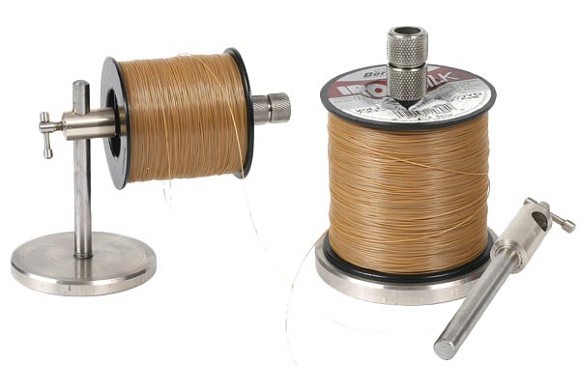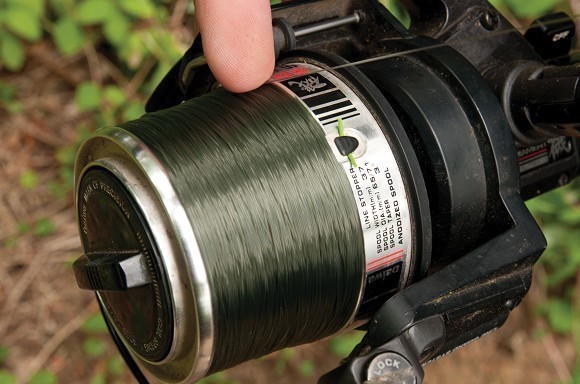
How to spool up your reels
In this fault fixer we take a look at the best ways to economically load-up your reels with line
1 “I always soak the bulk spool of mono before winding it onto the reel spools. At least for a few hours but ideally overnight. The line will darken right up as it absorbs the water.”
2 “The reason for doing this is to make the mono go incredibly limp just like braid. Nylon monofilament is hydroscopic (absorbs water) and as it soaks up water it goes softer making it easier to wind onto the reels smoothly.”
3 “There are various opinions regarding the best way to load mono in terms of how it should come off the bulk spool. Through trial and error I have found the best way to prevent any twist is to load the line with the bulk spool spinning i.e. with the spool held on a pen.”
4 “If nobody is available to assist you when loading line, stand the spool up in a tub of water with something loosely wedged up against it to prevent the spool from falling over. I use a Drennan bait box and a ceramic mug; it works perfectly!”
5 “With your reel on the butt section of a rod, thread the line through the butt guide and tie or tape to the base of the spool or the backing line already on the spool.”
6 “Now start winding the line onto the reel. Some people prefer to wind the line under tension through a towel, I just prefer to hold the line about a foot above the reel and wind it through my fingers under tension.”
7 “Placing tension on the line ensures it goes onto the reel spool nice and tight, bedding in properly.”
8 “Fill the reel spool right up to the lip. Overfilling will result in line spill and tangles.”
9 “Cut the line and either get fishing or secure the end under the line clip.”
10 “Good luck!”
Lots of larger reels, such as ‘big pit’ style reels have a spool size capable of holding much more line than you’re actually going to use, which means that to completely fill these spools with new or expensive line is a complete waste of your wonga! For example: if a spool holds 450yds of 15lb (0.35dia) line you’re realistically only ever going to make use of the first 250yds. This is enough to allow for the relatively low possibility of receiving a long run at extreme distance, as well as occasionally removing short sections of damaged line near the terminal end. So at least one third of the spool’s capability is only serving to fill the spool, which could also be achieved with old or cheaper lines – a practice known as, ‘backing-up’ the spool.
How to back-up your spools
First off, measure the depth of the spool with a piece of card and you do this by placing the card in the spool and marking off at the lip of the spool. Divide this measurement by the percentage you want to back-fill. For example: the spool holds 300yds of 15lb line, but you only want to load 200yds and back-up with 100yds. In this case you would divide the measurement into three. Cut-off one third next, so you are left with a measurement showing two-thirds of the spool depth.
Now begin to load the spool with old or budget line that’s no greater in diameter than your main line choice. This will provide better line-lay results. Continue to load this ‘back-up’ line until you think you’re around a third full. Place the card marking two-thirds of the depth and line capacity in the spool. If the second mark is level with the lip of the spool, you know you’ve added enough line; if not, continue until it does.
Tie on your main line next and economically fill the spool. Don’t be surprised to find you now only need one spool of line per three reels rather than two – now that’s what you call a money saver!
Cast further for longer
Without doubt the two most common problems to come from spooling up incorrectly are enhanced line twist and a casting distance and smoothness reduced by a spool being short of line. The dreaded line twist can also reduce casting distance, as coils of twisted line struggle to flow through the guiding rings or in some cases ‘frapping’ around them, halting the cast completely.
Ultimately these things end up damaging the line and shortening its life. Believe it or not, much of this line twist is actually added to the line before you even use it when you don’t use the correct technique for spooling-up. Unfortunately different lines react to different spooling methods in different ways, so here are the two main spooling techniques for you to see what works best with your chosen line.
Technique One
This method works particularly well with fluorocarbon main lines and heavy monos that retain a lot of spool memory from the storing bulk spool.
1 Begin by soaking the bulk spool in a bucket of warm (not hot) water. This will make the line suppler and remove some of the storage memory. It will also mean you can add some tension to the line with your finger and thumb when spooling-up without burning your skin via the friction heat.
2 Now pull a little line from the spool and note in which direction it leaves the bulk spool – clockwise or anti-clockwise. Place the spool on the ground so that the end of the spool that allows the line to leave in an anti-clockwise direction is facing you. This means that as you spool-up the coils in the line will load onto your reel in the same direction they are leaving the bulk spool.
3 Attach your reel to the butt section of a rod (you only need this half), thread the line through the guide ring and down to the reel. Tie the line to the spool and begin to load the line, but as you do so guide the line between your forefinger and thumb under tension. This will help remove line memory and give a better line-lay.
Technique Two
This technique works best with low diameter lines that are already quite supple with little existing twist or memory, as well as loading braid as the main line
1 Start by attaching your reel to the butt section of a rod and thread the line down to the reel via the guide ring before tying the line to the spool.
2 The next thing to do is half-fill a deep bucket with warm water (not hot) and drop the bulk spool of line into the water. Now make sure the bulk spool of line is lying on its side and not positioned with one end facing up.
3 Begin to wind the line onto the reel, again under the tension of your forefinger and thumb. The bulk spool will spin on the water surface within the bucket to allow a very quick loading of the reel where the line-lay will also benefit from the line being wet.






